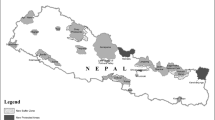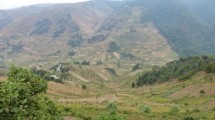Abstract
Successful management of forests, especially in the context of subsistence wood fuel use, can be improved by the application of theoretic models that predict patterns of use. A first step in this approach is understanding the decision rules of people using forests. While optimal foraging theory is normally applied to foraging for food, it also makes sense to apply it in the context of “foraging” for wood fuel. In this study, we applied a time allocation model of optimal foraging theory to wood gathering decisions in communities around Kakamega Forest, a mid-altitude seasonal tropical rain forest. The model predicts that the amount of wood gathered should increase with the distance to the wood source. We found that the predictions of OFT are supported, but only for adults and more strongly on a weekly scale. Based upon the results, we then discuss future improvements of the model to better understand and predict human use.





Similar content being viewed by others
Notes
There is considerable variability in family sizes, ranging from 1 to 16 (KNBS 2015), in the study area.
There is considerable variability in food types especially across seasons and household wealth.
The Kenya Forest Service (KFS) allows subsistence use with the purchase of a permit (about $1 USD per month), while the Kenya Wildlife Service (KWS) allows no extraction, with severe fines and jail time for offenders (Conservation and Management Act of 2013).
References
Abbot, P., Lowore, J., Khofi, C., and Werren, M. (1997). Defining Firewood Quality: A Comparison of Quantitative and Rapid Appraisal Techniques to Evaluate Firewood Species From a Southern African Savannah. Biomass and Bioenergy 12: 429–437.
Alakangas, E. (2005). Properties of wood fuels used in Finland. Technical Research Centre of Finland, VVT Process, Project Report. 90p.
Bettinger, R. L. (2009). Hunter-Gatherer Foraging: Five Simple Models, Eliot Werner Publications, New York.
Bettinger, R. L., Ripan, M., and McCarthy, H. (1997). Central Place Models of Acorn and Mussel Processing. Journal of Archaeological Science 24(10): 887–899.
Bird, D. W., and Bird, R. B. (2000). The Ethnoarchaeology of Juvenile Foragers: Shellfishing Strategies Among Meriam Children. Journal of Anthropological Archaeology 19: 461–475.
Bleher, B., Ulster, D., and Bergsdorf, T. (2006). Assessment of Threat Status and Management Effectiveness in Kakamega, Forest Kenya. Journal of Biodiversity and Conservation 15: 1159–1177.
Blurton-Jones, N. G., Hawkes, K., and Draper, P. (1994). Differences between Hadza and !Kung children’s work: original affluence or practical reason? In Burch Jr., E. S., and Ellanna, I. J. (eds.), Key Issues in Hunter-Gatherer Research, Oxford/Providence, Berg, pp. 189–215.
Blurton-Jones, N. G., Marlowe, F. W., Hawkes, K., and O’Connell, J. F. (2000). Paternal investment and hunter-gatherer divorce rates. In Cronk, L., Chagnon, N., and Irons, W. (eds.), Adaptation and Human Behavior: An Anthropological Perspective, Aldine de Gruyter, Hawthorne, pp. 65–86.
Bonjour, S., Adair-Rohani, H., Wolf, J., Bruce, N. G., Mehta, S., Prüss-Ustün, A., et al (2013). Solid Fuel Use for Household Cooking: Country and Regional Estimates for 1980–2010. Environmental Health Perspectives 121(7): 784–790.
Charnov, E. L. (1976). Optimal Foraging, the Marginal Value Theorem. Theoretical Population Biology 9(2): 129–136.
Daly H. and Walton M. A. (2017). Energy Access Outlook 2017: Special Report: Poverty to Prosperity. International Energy Agency. https://www.iea.org/publications/freepublications/publication/WEO2017SpecialReport_EnergyAccessOutlook.pdf.
Di Marco, M., Buchanan, G. M., Szantoi, Z., Holmgren, M., Marasini, G. G., Gross, D., and Rondinini, C. (2014). Drivers of Extinction Risk in African Mammals: The Interplay of Distribution State, Human Pressure, and Conservation Response and Species Biology. Philosophical Transactions of the Royal Society of London B: Biological Sciences 369(1643): 20130198.
Dohoo, C., Vanleeuwen, J., Read Guernsey, J., Critchle, K., and Gibson, M. (2013). Impact of Biogas Digesters on Wood Utilisation and Self-reported Back Pain for Women Living on Rural Kenyan Smallholder Dairy Farms. Global Public Health 8: 221–235.
Eco2librium (Eco2). (2016). Stoves for Life Monitoring Report – 2016. Document Submitted to Gold Standard (www.goldstandard.org).
Fuwape, J. A., and Akindele, S. O. (1996). Biomass Yield and Energy Value of Some Fast-Growing Multipurpose Trees in Nigeria. Biomass and Bioenergy 12: 101–106.
Githiomi, J. K., and Odour, N. (2012). Strategies for Sustainable Wood Fuel Production in Kenya. International Journal of Applied Science and Technology 2: 21–25.
Gregory, A. J., Lung, M., Gehring, T., and Swanson, B. (2009). The Importance of Sex and Spatial Scale when Evaluating Sexual Segregation by Elk in Yellowstone. Journal of Mammalogy 90(4): 971–979.
Guthiga, P., and Mburu, J. (2006). Local Communities’ Incentives for Forest Conservation: Case of Kakamega Forest in Kenya. Proceedings of the 11th Conference of the International Association for the Study of Common Property. Bali.
Harsha, H., Gopikumar, K., Samom, K., Hegde, N. and Jha, S. K. (2011). Calorific Value Assessment of Selected Tropical Tree Species of the Southern India for Higher Fuelwood Potential. Indian Journal of Ecology Special Issue 38:194–195.
Hill, K., Kaplan, H., Hawkes, K., and Hurtado, A. M. (1987). Foraging Decisions Among Ache Hunter-Gatherers: New Data and Implications for Optimal Foraging Models. Ethology and Sociobiology 8(1): 1–36.
International Energy Agency. (2014). Africa energy outlook: a focus on energy prospects in Sub-Saharan Africa. World Energy Outlook Special Report. http://www.iea.org/publications/freepublications/publication/WEO2014_AfricaEnergyOutlook.pdf.
Kaplan, H., and Hill, K. (1992). The Evolutionary Ecology of Food Acquisition. In E.A. Smith and B. Winterhalden (Eds.), Evolutionary Ecology and Human Behavior: pages 167–201. New York, de Grutyer.
Kefa, C.A. (2016). Assessing the Impacts of Bioenergy Extraction and Human Land use of the Biodiversity of Kakamega Tropical Rainforest, Kenya. Diss. Bowling Green State University.
Kefa, C. A., Lung, M., Espira, A., and Gregory, A. (2017). Quantifying the Rate of Subsistence Wood Harvesting from a Tropical Rainforest in Kenya. Oryx 5: 1–5.
Kiefer, S., and Bussmann, R. W. (2008). Household Energy Demand and its Challenges for Forest Management in the Kakamega Area, Western Kenya. Ethnobotany Research and Applications 6: 363–371.
Kituyi, E., Marufu, L., Wandiga, S. O., Jumba, I. O., Andreae, M. O., and Helas, G. (2001a). Biofuel Consumption Rates and Patterns in Kenya. Biomass and Bioenergy 20(2): 83–99.
Kituyi, E., Marufu, L., Wandiga, S. O., Jumba, I. O., Andreae, M. O., and Helas, G. (2001b). Biofuel Availability and Domestic Use Patterns in Kenya. Biomass and Bioenergy 20: 71–82.
KNBS (Kenya National Bureau of Statistics) 2015. 2015/16 Kenya Integrated Household Budget Survey (KIHBS) – Measuring Well-Being for Sustainable Development Status Report.
Krajnc, N. (2015). Wood Fuels Handbook. Food and Agriculture Organization Of The United Nations. Pristina, Kosovo.
Legros, G., Havet, I., Bruce, N., and Bonjour, S. (2009). The Energy Access Situation in Developing Countries: A Review Focusing on the Least Developed Countries and Sub-Saharan Africa, United Nations development Programme and World Health Organization, New York.
Lung, M. A., and Childress, M. J. (2006). The Influence of Conspecifics and Predation Risk on the Vigilance of Elk (Cervus elaphus) in Yellowstone National Park. Behavioral Ecology 18(1): 12–20.
Lung, M., and Espira, A. (2015). The Influence of Stand Variables and Human Use on Biomass and Carbon Stocks of a Transitional African Forest: Implications for Forest Carbon Projects. Forest Ecology and Management 351: 36–46.
Lung, T., and Schaab, G. (2007). Assessing Fragmentation and Disturbance of West Kenyan Rainforests by Means of Remotely Sensed Time Series Data and Landscape Metrics. African Journal of Ecology 44: 1–16.
MacArthur, R. H., and Pianka, E. R. (1966). On Optimal Use of a Patchy Environment. The American Naturalist 100(916): 603–609.
Madsen, D. B., and Schmitt, D. N. (1998). Mass Collecting and the Diet Breadth Model: A Great Basin Example. Journal of Archaeological Science 25(5): 445–455.
Marston, J. M. (2009). Modeling wood acquisition strategies from archeological charcoal remains. Journal of Archeological Sciences 36: 2192-2200.
Metcalfe, D., and Barlow, K. (1992). A model for Exploring the Optimal Trade-off Between Field Processing and Transport. American Anthropologist 94(2): 340–356.
Munalula, F., and Meincken, M. (2009). An Evaluation of South African Fuelwood with Regards to Calorific Value and Environmental Impact. Biomass and Bioenergy 33(3): 415–420.
Practical Action (2016). Poor People's Energy Outlook 2016, Practical Action Publishing Ltd., Rugby.
Rüger, N., Williams-Linera, G., Kissling, D. W., and Huth, A. (2008). Long-Term Impacts of Fuelwood Extraction on a Tropical Montane Cloud Forest. Ecosystems 11(6): 868–881.
Sassen, M., Sheil, D., and Giller, K. E. (2015). Fuelwood Collection and its Impacts on a Protected Tropical Mountain Forest in Uganda. Forest Ecology and Management 354: 56–67.
Schweik, C. M. (2000). Optimal Foraging, Institutions and Forest Change: A Case from Nepal. Environmental Monitoring and Assessment 62(3): 231–260.
Smith, E. A. (1983). Anthropological Applications of Optimal Foraging Theory: A Critical Review. Current Anthropology 24(5): 625–651.
Smith, E. A. (1991). Inujjuamiunt Foraging Strategies: Evolutionary Ecology of an Arctic Hunting Economy, Transaction Publishers, New York.
Specht, M. J., Pinto, S. R. R., Albuquerque, U. P., Tabarelli, M., and Melo, F. P. L. (2015). Burning Biodiversity: Fuelwood Harvesting Causes Forest Degradation in Human-Dominated Tropical Landscapes. Global Ecology and Conservation 3: 200–209.
Tucker, B. (2007). Applying Behavioral Ecology and Behavioral Economics to Conservation and Development Planning: An Example from the Mikea Forest, Madagascar. Human Nature 18(3): 190–208.
Wass, P. (1995). Kenya's Indigenous Forests. IUCN, Gland, Switzerland, and Cambridge, UK in collaboration with ODA.
Winterhalder, B., and Lu, F. (1997). A Forager-Resource Population Ecology Model and Implications for Indigenous Conservation. Conservation Biology 11(6): 1354–1364.
Winterhalder, B., and Smith, E. A. (2000). Analyzing Adaptive Strategies: Human Behavioral Ecology at Twenty-five. Evolutionary Anthropology 51: 2–7.
Acknowledgements
We thank the Kenya National Commission for Science and Technology, Kenya Forest Service and Kenya Wildlife Service for granting us permits to undertake this study and the County government of Kakamega County for approving our research permit, our collaborators at the National Museum of Kenya for administrative, logistical and technical support, the anonymous participants who spoke with us and allowed us to weigh their wood bundles, Bowling Green State University for material, financial and technical support, Dr. Kefa Otiso and Genetic Research in Applied Spatial Ecology Lab members for their comments, the technicians Emma Spence, Gregory Brinkman, and Nadejda Mirochnitchenko, Eco2librium staff, and in particular.
Herbert Imbuka, for their assistance with interviews, and two anonymous reviewers for their critiques.
Author information
Authors and Affiliations
Contributions
CAK and AJG designed the project and collected the data. MAL analyzed the data. MAL, AJG and AE wrote the article. MAL and AE helped with acquisition of necessary research permits from the Kenyan government.
Corresponding author
Ethics declarations
Conflict of Interest
The authors declare that there are no conflicts of interest.
Informed Consent
Field methods were reviewed by the Bowling Green State University Human Subjects Research Board and were granted a waiver of approval prior to the start of fieldwork. All research was conducted with the knowledge and approval of the legal governing bodies of Kenya and the Kakamega Forest, namely, Kenya National Commission for Science and Technology, Kenya Forest Service, Kenya Wildlife Service, the County Government of Kakamega and the State Department of Education.
Rights and permissions
About this article
Cite this article
Kefa, C.A., Gregory, A., Espira, A. et al. Does Wood Fuel Gathering for Household Use Follow an Optimality Model? A Study from Kakamega Forest, Western Kenya. Hum Ecol 46, 473–484 (2018). https://doi.org/10.1007/s10745-018-0010-2
Published:
Issue Date:
DOI: https://doi.org/10.1007/s10745-018-0010-2




